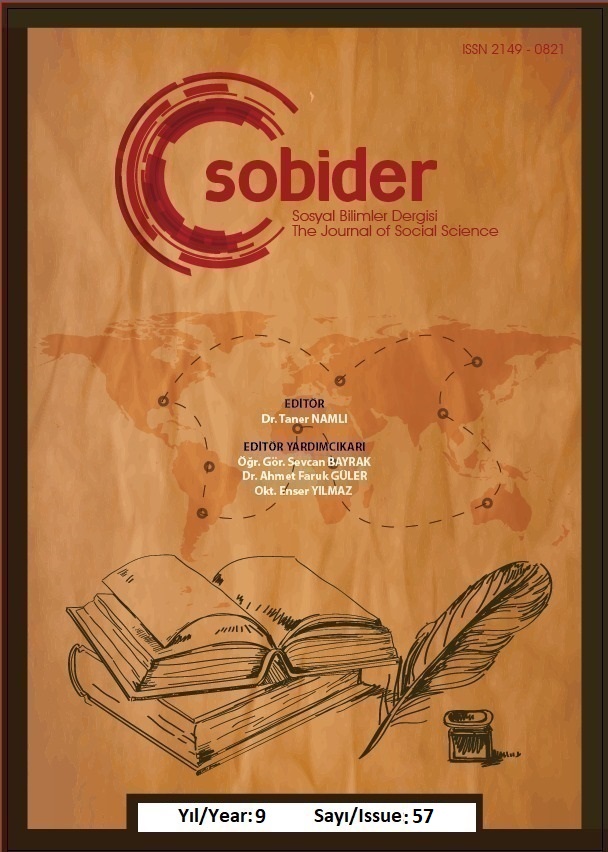EVLİYA ÇELEBİ SEYAHATNAMESİ’NİN DOKUZUNCU CİLDİNDE YER ALAN MUĞLA’DA DEYİM, AĞIZ VE DİĞER KALIPLAŞMIŞ DİL BİRİMLERİNİN VARLIĞI
Author :
Abstract
Evliya Çelebi, XVII. yüzyılın en önemli Türk gezginidir. Kendisi dönemin imparatorluk coğrafyasının pek çok yerini gezmiş, buralarda derlediği malzemeyi Türkçe olarak on ciltlik Seyahatname adlı eserinde yer vermiştir. Seyahatname’de Çelebi gittiği yerlerin tarihî, edebî, kültürel, ekonomik, sanatsal, sosyal, siyasal olaylarına yer vermiştir. Bu ve buna benzer özellikleriyle Seyahatname, disiplinlerarası hatta üstü bir eserdir.
Evliya, Seyahatname’nin her bir cildini farklı coğrafyalardaki mekanlara ayırmıştır. Bu on cildin dokuzuncusunda Muğla’ya değinmiştir. Yazar, gezdiği bugünkü Muğla’nın Menteşe, Mekri (Fethiye), Bodurum (Bodrum), Milas, Marmaris gibi yerleşim yerlerini gezmiştir.
Çelebi; klasik Osmanlı Türkçesinin en ağır ve süslü dönemi olan XVII. asırda yaşamasına rağmen Seyahatname’nin Muğla bölümünde de yazı dilinin karakteristik özelliklerine değil konuşma dilinin genel özelliklerine bağlı kalarak eserini tamamlamıştır. Bu sebeple Seyahatname’nin Muğla bölümün söz varlığında zengin bir şekilde deyimler, ağız özellikleri ve kalıplaşmış dil birimleri görülmektedir.
Keywords
Abstract
Evliya Celebi is the most important Turkish traveler of the 17th century. He traveled to many places in the imperial geography of the period, and included the material he compiled in these places in his ten-volume Seyahatname, in Turkish. In the Seyahatname, Celebi included the historical, literary, cultural, economic, artistic, social and political events of the places he visited. With these and similar features, Travelogue is an interdisciplinary and even superior work.
Evliya divided each volume of the Seyahatname into places in different geographies. He mentioned Mugla in the ninth of these ten volumes. The author visited the settlements of today’s Mugla such as Mentese, Mekri (Fethiye), Bodurum (Bodrum), Milas, Marmaris.
Celebi; although he lived in the 17th century, the heaviest and most ornate period of classical Ottoman Turkish, he completed his work in the Mugla section of the Seyahatname by adhering to the general characteristics of the spoken language, not the characteristic features of the written language. For this reason, idioms, dialect features and stereotyped language units are seen richly in the vocabulary of the Muğla section of the Seyahatname.
Keywords
- Anetshofer, H. (2012). Seyahaname’de Dilbilime Dair Kaynaklar, Evliya Çelebi
- Anetshofer, H. (2012). Seyahaname’de Dilbilime Dair Kaynaklar, Evliya Çelebi
- Seyahatnamesi’nin Yazılı Kaynakları. editörler: Hakan Karateke, Hatice Aynur, TTK, Ankara.Dağlı, Y.; Kahraman, S. A.; Dankoff, R. (1996-2007). Evliya Çelebi Seyahatnamesi, YKY, İstanbul.
- Dankoff, R. (2004), Evliya Çelebi Seyahatnamesi Okuma Sözlüğü, Katkılarla İngilizceden Çeviren Semih Tezcan, Türk Dilleri Arastırmaları Dizisi: 37; İstanbul.
- Develi, H. (1995). Evliya Çelebi Seyahatnamesine Göre 17. Yüzyıl Osmanlı Türkçesinde Ses Benzeşmeleri ve Uyumlar, TDK, Ankara.
- Duman, M. (1995). Evliya Çelebi Seyahatnamesine Göre 17. Yüzyılda Ses Değişmeleri, TDK, Ankara.
- İlgürel, M. (1995). Evliya Çelebi, TDV İslam Ansiklopedisi, İstanbul, 1995, 11. cilt, s. 529-533.Kahraman, Seyit Ali; Dağlı, Yücel (2005). Evliya Çelebi Seyahatnamesi 9. Kitap, Yapı Kredi Yayınları, İstanbul.
- Karasar, N. (2009). Bilimsel Araştırma Yöntemi. Ankara, Nobel Yayıncılık.Kubbealtı Lugati (t.y.) 19.04.2022 tarihinde http://lugatim.com/s/deyim ve http://lugatim.com/s/a%C4%9F%C4%B1z adresinden erişilmiştir.
- Tezcan, N.(2009a) Seyahatname, TDV İslam Ansiklopedisi, İstanbul, 37. cilt, s. 16-19. Tezcan, N. (2009b). Çağının Sıradışı Yazarı Evliya Çelebi, YKY, İstanbul.
- Türk Dil Kurumu (t.y.) Güncel Türkçe Sözlük, 19.04.2022 tarihinde https://sozluk.gov.tr/ adresinden erişilmiştir.
- Türk Dil Kurumu (t.y.) Derleme Sözlüğü, 20.04.2022 tarihinde https://sozluk.gov.tr/ adresinden erişilmiştir.
- Türk Dil Kurumu (t.y.) Atasözleri ve Deyimler Sözlüğü, 20.04.2022 tarihinde https://sozluk.gov.tr/ adresinden erişilmiştir.





